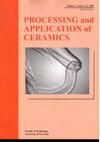Effect of annealing temperature and cadmium doping on structure and magnetic properties of neodymium orthoferrite nanoparticles synthesized by a simple co-precipitation method
IF 0.8
4区 材料科学
Q3 MATERIALS SCIENCE, CERAMICS
引用次数: 1
Abstract
A series of Nd1-xCdxFeO3 (x = 0.1, 0.2 and 0.3) nanoparticles were successfully synthesized from Nd(III), Cd(II) and Fe(III) nitrates by a simple co-precipitation method in boiling water with a 5% sodium hydroxide aqueous solution (without any surfactants) and annealed at 700, 850 and 950?C for 1 h. SEM and TEM analyses showed particle sizes in the range of 50-70 nm. According to XRD the average crystallite size increased with the annealing temperature, but decreased when the cadmium concentration increased. As the annealing temperature was raised from 700 to 950?C, the magnetic properties, such as coercivity (Hc), remanent magnetization (Mr) and saturation magnetization (Ms), of the Nd0.8Cd0.2FeO3 sample also increased. In general, the Hc, Mr and Ms values increased with the degree of cadmium doping. The synthesized Nd1-xCdxFeO3 nanopowders havemuch larger coercivity values than some other rare-earth perovskites, such as Nd1-xSrxFeO3, NdFe1-xCoxO3, LaFe1-xTixO3, YFe1-xNixO3, Y1-xCdxFeO3, La1-xCdxFeO3 or Bi1-xCdxFeO3. The high Hc value (1916.52-4833.41Oe) of the synthesized Nd1-xCdxFeO3 nanopowders enables their use for permanent magnets or magnetic recording on hard disks and tapes.退火温度和镉掺杂对共沉淀法合成的钕铁氧体纳米粒子结构和磁性能的影响
以硝酸Nd(III)、Cd(II)和Fe(III)为原料,在5%氢氧化钠水溶液(不含任何表面活性剂)的沸水中采用简单共沉淀法成功合成了一系列Nd1-xCdxFeO3 (x = 0.1、0.2和0.3)纳米颗粒,并在700、850和950℃下退火。扫描电镜和透射电镜分析表明,颗粒尺寸在50-70 nm之间。XRD结果表明,平均晶粒尺寸随退火温度的升高而增大,随镉浓度的升高而减小。当退火温度从700℃提高到950℃时?C, Nd0.8Cd0.2FeO3样品的矫顽力(Hc)、剩余磁化强度(Mr)和饱和磁化强度(Ms)等磁性能也有所提高。总的来说,Hc、Mr和Ms值随着镉掺杂程度的增加而增加。与其它稀土钙钛矿(Nd1-xSrxFeO3、NdFe1-xCoxO3、LaFe1-xTixO3、YFe1-xNixO3、Y1-xCdxFeO3、La1-xCdxFeO3或Bi1-xCdxFeO3)相比,所合成的Nd1-xCdxFeO3纳米粉体具有更大的矫顽力值。合成的Nd1-xCdxFeO3纳米粉体具有高Hc值(1916.52-4833.41Oe),可用于永磁体或硬盘和磁带的磁记录。
本文章由计算机程序翻译,如有差异,请以英文原文为准。
求助全文
约1分钟内获得全文
求助全文
来源期刊

Processing and Application of Ceramics
MATERIALS SCIENCE, CERAMICS-
CiteScore
1.90
自引率
9.10%
发文量
14
审稿时长
10 weeks
期刊介绍:
Information not localized
 求助内容:
求助内容: 应助结果提醒方式:
应助结果提醒方式:


